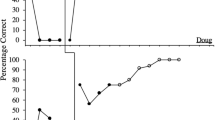Abstract
The purpose of this paper is to better understand how altruistic behavior varies by gender, race, age, and dress. Eagly & Crowley’s (1986) social role theory maintains that the traditional male sex role promotes heroic and chivalrous helping behavior. Based on this theoretical insight, we hypothesized that men would be more likely to exhibit helping behavior than women (regardless of their race, age, or dress), especially if the person requiring assistance was a woman. We also expected that fewer women than men would offer assistance to another, especially if the person in need of help was a man. To test our hypotheses, we went to the downtown Waterside Festival Marketplace, where male and female actors “dropped” a stack of books. We found no significant differences in helping behavior between male and female subjects, all else being equal.
Similar content being viewed by others
References
Andreoni, James and Lise Vesterlund. “Which is the Fairer Sex? Gender Differences in Altruism.” Quarterly Journal of Economics 116 (2001): 293–312.
Barnett, Mark A., Guy D. Vitaglione, Jeffrey S. Bartel, and Fred W. Sanborn. “Perceptions of Self-Oriented and Other-Oriented ‘Everyday’ Helpers.” Current Psychology 19 (2000): 87–115.
Baskerville, Kim, Kevin Johnson, Elizabeth Monk-Turner, Quita Slone, Helen Standley, Shannon Stansbury, Mirta Williams, and Jamie Young. “Reactions to Random Acts of Kindness.” The Social Science Journal 37 (2000): 293–302.
Belansky, Elaine S. and Ann K. Boggiano, “Predicting Helping Behaviors: The Role of Gender and Instrumental/Expressive Self-Schemata.” Sex Roles: A Journal of Research 30 (1994): 647–62.
Eagly, A. and M. Crowley. “Gender and Helping Behavior: A Meta-Analytical Review of the Social Psychological Literature.” Psychology Bulletin 100 (1986): 283–308.
Goodman, Michael D. and Karen C. Garei. “The Influence of Status on Decisions to Help.” The Journal of Social Psychology 133 (1993): 23–32.
Jeffries, Vincent. “Virtue and the Altruistic Personality.” Sociological Perspectives 41 (1998): 151–67.
Rabinowitz, Frederic E., Leah Sutton, Tony Schutter, Abby Brown, Carissa Krizo, John Larse, Jim Styn, Abby Welander, Denette Wilson, and Sarah Wright. “Helpfulness to Lost Tourists.” The Journal of Social Psychology 137 (1997): 502–10.
Rushton, J. Philippe. Altruism, Socialization, and Society. Englewood Cliffs, NJ: Prentice-Hall, 1980.
Stanko, Elizabeth. Intimate Intrusions: Women's Experience of Male Violence, London: Unwin Hyman, 1985.
Author information
Authors and Affiliations
Additional information
Elizabeth Monk-Turner is professor of sociology and criminal justice, and chair at Her primary research interests are in education, gender, and labor markets. A developing research interest is in better understanding the factors that shape altruistic behavior.
Rights and permissions
About this article
Cite this article
Monk-Turner, E., Blake, V., Chniel, F. et al. Helping hands: A study of altruistic behavior. Gend. Issues 20, 65–70 (2002). https://doi.org/10.1007/s12147-002-0024-2
Issue Date:
DOI: https://doi.org/10.1007/s12147-002-0024-2




